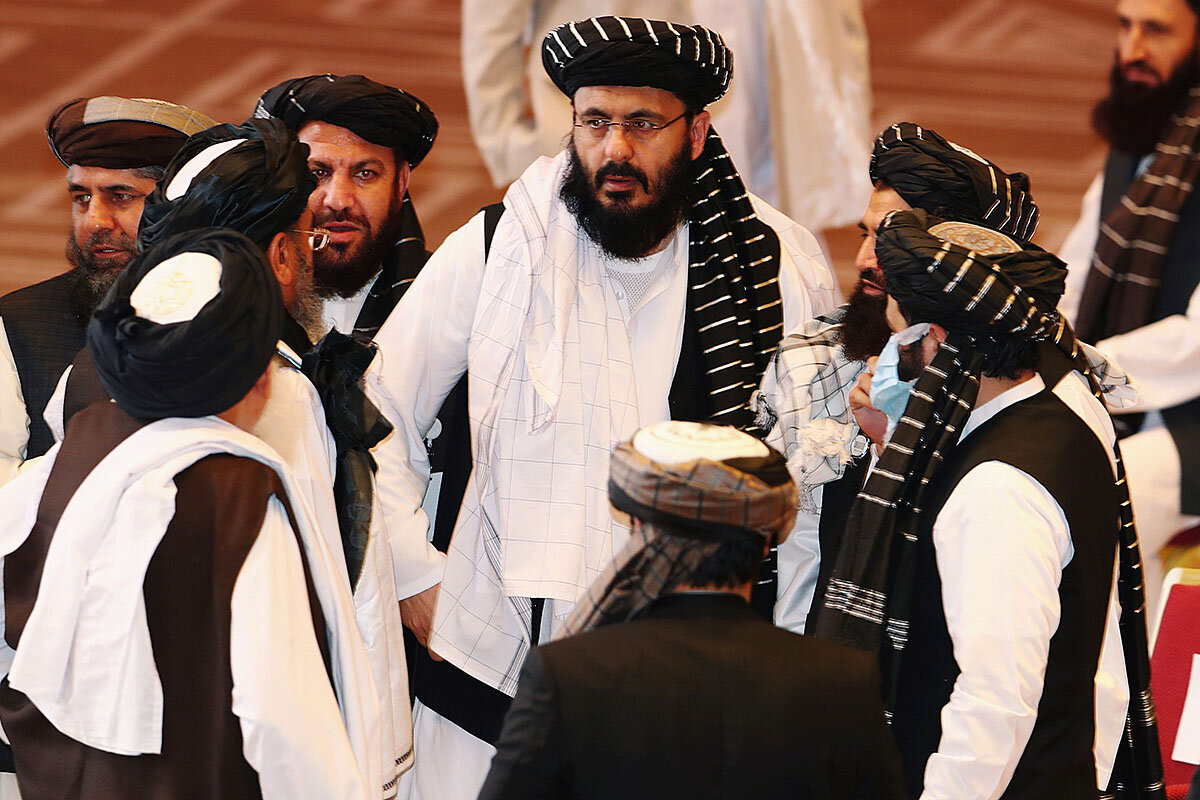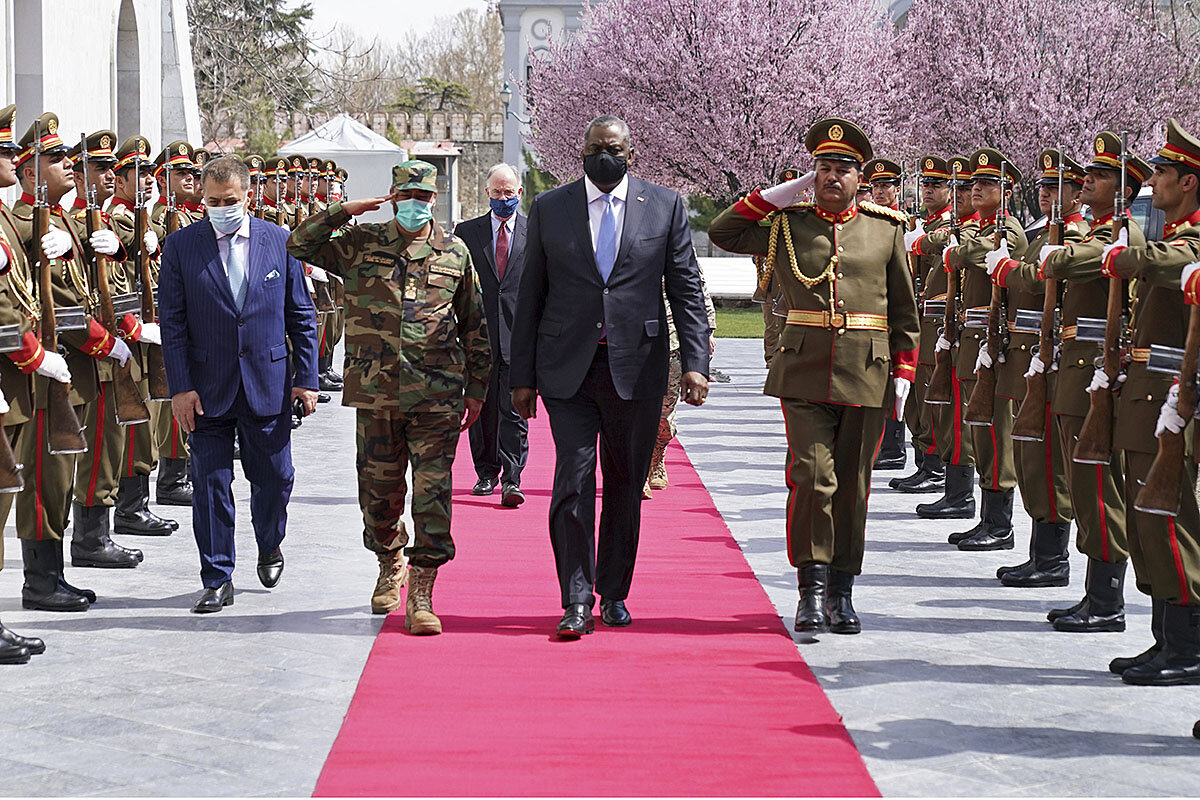Afghanistan: Can Biden dodge failure and forge his own peace?
Loading...
| LONDON
When American forces ousted the Taliban from power nearly 20 years ago in the aftermath of the 9/11 attacks, then-President George W. Bush vowed to break the curse of the so-called graveyard of empires.
The history of military conflicts in Afghanistan, Mr. Bush noted, was “one of initial success, followed by long years of floundering and ultimate failure.”
“We’re not going to repeat that mistake,” he said.
Why We Wrote This
Perhaps, in Afghanistan, success is the absence of failure. Ahead of a fast-approaching deadline, President Joe Biden is making a list-ditch effort to preserve both U.S. interests and Afghan progress.
Yet today, just weeks away from an inherited May 1 deadline to withdraw U.S. troops, President Joe Biden is scrambling to avoid precisely that verdict, with plans to convene multilateral peace talks in Turkey meant to jump-start last-ditch diplomacy.
The president is torn between the desires to quickly end America’s longest-ever war, and also – in light of Taliban battlefield advances, and a recent Taliban-driven assassination campaign – to leave Afghanistan “responsibly,” preserving both U.S. strategic interests and Afghanistan’s hard-won civil society and democratic gains.
Yet pointedly, after a more than $2 trillion investment in the war and nation building that has cost thousands of American and tens of thousands of Afghan lives, the question remains: What, if anything, can Mr. Biden do now to avert catastrophe? Can this White House make its own peace with the Taliban?
The Taliban have been loudly declaring victory over a superpower, ever since agreeing to a deal with President Donald Trump in February 2020. That deal spelled out hard U.S. and NATO pullout deadlines, but imposed few restraints on Taliban attacks against other Afghans, which have continued unabated, or required few concrete moves toward peace.
The Taliban have promised a violent “reaction” if the 3,500 remaining American and roughly 8,000 NATO troops do not leave by May 1, a deadline that President Biden said would be “tough” to meet. At the same time, U.S. intelligence agencies also warn of a Taliban takeover and collapse of the U.S.-backed government in Kabul, if foreign forces leave precipitously.
Chances of a diplomatic success are so small that even U.S. officials liken to a “moonshot” their bid to jump-start intra-Afghan peace talks – starting with the conference in Turkey slated for later this month – that would lead to an interim “peace government” as laid out in an eight-page plan leaked last month.
“The administration has a moonshot idea, but it is also matching that moonshot idea with some major effort,” says Asfandyar Mir, an expert in political violence at Stanford University’s Center for International Security and Cooperation. “This plan is ambitious. Getting this intra-Afghan agreement is going to be very, very tough. But the good news is that they are literally throwing everything they can at the problem.”
“Everything has to work out”
As the United States plans to convene the Turkey meeting under United Nations auspices, it has called on the Russians, Iranians, and other regional stakeholders like India, and has “energized” communication with the Pakistanis, whose ISI intelligence service has significant influence over the Taliban, notes Mr. Mir.
“There are a lot of moving parts. For this to work out, everything has to work out,” he says. That means convincing the Taliban to agree to a temporary, monthslong extension of the foreign troop presence – a critical step the Islamist movement has so far rejected.
An initial power-sharing arrangement may also be possible, but the price of Taliban buy-in may be that the “final settlement will be extremely favorable to the Taliban,” says Mr. Mir.
“It’s not perfect. I’m not saying that this is fixable,” he adds. “We’re trying to window-dress a failed mission at this point. ... It should really go without saying that the main objective here is to ensure a U.S. withdrawal which is not embarrassing. Any grand goal of major peace, or victory for one side or the other, is just not realistic.”
Still, the White House is attempting to recalibrate a deal that in many ways left the Taliban in the driver’s seat.
In recent days, U.S. envoy Zalmay Khalilzad presented both sides with a new set of nine principles reportedly meant to guide the upcoming Turkey conference. They include a permanent cease-fire – long an upfront demand of the government, but rejected by the Taliban – and commitments to equality, human rights, and free elections. The Americans also hope for a 90-day reduction in violence, aiming to prevent a Taliban spring offensive.
Hard lines
The Taliban, meanwhile, have not yet agreed to go to Turkey, much less accept measures that go far beyond their deal with Mr. Trump, who analysts say rushed to end America’s so-called forever war with little apparent regard for consequences.
And Afghan media report that the Taliban, in exchange for permitting U.S. forces to stay 45 to 90 days beyond May 1, are demanding the release of 7,000 more prisoners – on top of some 5,500 reluctantly set free by the government last year – and the removal of leaders’ names from a U.N. sanctions blacklist.
The Kabul government is also hewing to a hard line. Afghanistan’s first vice president, Amrullah Saleh, said Sunday that the Turkey agenda affirms civil society “achievements” since the Taliban were ousted in 2001, emphasizing that the Taliban “must accept that Afghanistan will not become Taliban.”
Are “the Taliban seeking to come and lash people and we will stay silent? Never,” he said.
But getting the Taliban to make any new compromises won’t be easy, after they gave up so little in negotiations with Mr. Trump, says Rahmatullah Amiri, an independent analyst based in Kabul.
“It’s wishful thinking that this Turkey conference will produce something,” says Mr. Amiri. “The Taliban will be there, if they are wanted. They will sit there, but it won’t produce anything. The Taliban want nothing less or more than complete power.
“They know that the golden era of Trump is never coming back. It is like, at this crucial moment, God revealed this gift [Mr. Trump] to them, and the guy gave them literally every key to the padlock,” he says. “What can Biden do? It’s too late, because now the Taliban already tasted victory.”
The result is a series of bad choices for the Biden administration, as it tries to weigh the risks and benefits of delaying the withdrawal of U.S. forces. The draft U.S. peace agreement points to American aspirations of preserving gains in women’s rights, free speech, and elections to choose leaders, all to be enshrined in a new constitution.
But it also ambitiously calls for creation of a new “transitional Peace Government” at the start of the process, jointly formed by the Taliban and the U.S.-backed government of President Ashraf Ghani, who would have to step down.
In addition to the cease-fire, it calls for the Taliban moving “military structures” from neighboring countries, such as Pakistan – also unacceptable to the Taliban so far.
After the U.S. leaves, then what?
Yet analysts note that, even if agreement is reached, it might not last beyond a U.S. departure.
“It’s highly unlikely that a peace process will survive an American military withdrawal,” Laurel Miller, a former top State Department official in charge of Afghanistan and Pakistan diplomacy, who is now director of the Asia program at the International Crisis Group, said in a recent webinar. “Therefore, to protect American interests, you would have to consider what it is you want to leave behind when you pull out.”
Creating a joint transitional government first puts both Afghanistan and the U.S. “in a much worse position,” she said, “because that weak, fragile, power-sharing artifact would perish with the peace process and you’d be left with nothing.”
Mr. Biden must be “very careful” further thinning the low current level of U.S. and NATO troops, says Mr. Mir at Stanford, noting that the “best case” for the Taliban is a “political meltdown, a total fragmentation of the Afghan security forces and Afghan government.”
Western forces are “not putting any meaningful pressure on the Taliban, [but] once you pull these troops out, then you are likely to see things like defections, wholesale splintering, a total collapse of command and control, and that’s the situation you want to avoid,” he says.
“Given that the American empire has survived, we gloss over the fact that the U.S. war in Afghanistan has been a failure,” he says. “For now, the U.S. strategy has to be to make sure the Afghan government stays in the fight.”








